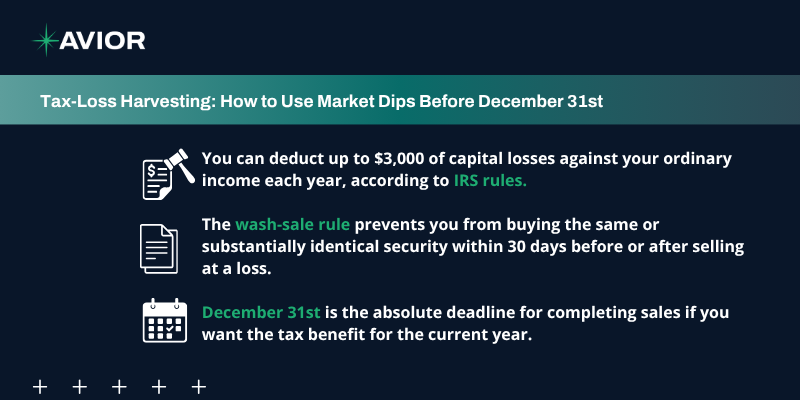Tax-Loss Harvesting: How to Use Market Dips Before December 31st

You open your investment statement in late November, and your stomach drops. Some stocks are down 15%, others 20%. That tech fund you bought with such confidence in January?
Down considerably. Your first instinct might be to look away and hope things improve. But those losses sitting in your portfolio could actually reduce your tax bill if you act strategically before year-end.
This strategy is called tax-loss harvesting, and it’s one of the most practical tax-saving techniques available to investors. The concept is straightforward: you sell investments that have dropped in value, use those losses to offset your gains, and potentially lower your taxes. But there’s a firm deadline — December 31st. Miss it, and you’ll have to wait until next year to capture those tax benefits. Whether you’re dealing with a down market or just looking to optimize your tax situation, understanding how to use tax-loss harvesting before the year ends could save you thousands of dollars.
Key Takeaways
- Tax-loss harvesting lets you sell losing investments to offset capital gains and reduce your overall tax bill.
- You can deduct up to $3,000 of capital losses against your ordinary income each year, according to IRS rules.
- The wash-sale rule prevents you from buying the same or substantially identical security within 30 days before or after selling at a loss.
- December 31st is the absolute deadline for completing sales if you want the tax benefit for the current year.
- Even without capital gains, tax-loss harvesting can lower your taxable income and carry forward unused losses to future years.
- Working with a professional helps you maximize tax savings while avoiding common mistakes that could disqualify your strategy.
Understanding Tax-Loss Harvesting
Tax-loss harvesting is the practice of selling investments that have declined below what you paid for them. When you do this, you “realize” a loss that the IRS allows you to use for tax purposes.
Here’s how it works in simple terms. If you sell Stock A for a $10,000 gain, you’d normally owe capital gains tax on that profit. But if you also sell Stock B at a $10,000 loss during the same tax year, these two amounts cancel each other out. Your taxable capital gains? Zero.
The $3,000 Income Offset Rule
What happens if your losses exceed your gains? The IRS offers an additional benefit. You can use up to $3,000 of excess capital losses to reduce your regular income each year. This applies to income from sources like your salary, interest, or rental properties.
Any remaining losses beyond $3,000 don’t disappear. You can carry them forward to offset gains or income in future tax years. This creates a tax-loss “bank account” that grows as you harvest losses and shrinks as you use them to offset future gains.
Why December 31st Is The Deadline
Time matters in tax-loss harvesting because the IRS operates on a calendar-year basis. To claim investment losses on this year’s return, you must complete the sale by December 31st. Not the trade date — the settlement date.
Understanding Trade vs. Settlement Dates
Most stock transactions now take one business day to settle (known as T+1). This means if you want a loss to count for 2025, you need to place your trade no later than December 31st, since the IRS uses the trade date, not the settlement date, to determine the tax year.
Wait until January 2nd to sell? That transaction will count in 2026, making it a 2026 tax event. You’ll lose an entire year of potential tax benefits because you waited too long.
How the Wash-Sale Rule Changes Everything
The wash-sale rule exists to prevent investors from gaming the system. Under this IRS regulation, if you sell a security at a loss and then buy the “same or substantially identical” security within 30 days before or after the sale, your loss gets disallowed for tax purposes.
The 61-Day Window
Think of it as a 61-day window — 30 days before your sale, the sale date itself, and 30 days after. During this entire period, you cannot purchase the same investment if you want to claim your loss.
The rule is strict. It applies to purchases in any of your accounts, including your IRA or 401(k). It even extends to your spouse’s accounts. Buy the same stock in your taxable account while your spouse buys it in their IRA? The wash-sale rule still applies.
What “Substantially Identical” Means
The IRS hasn’t provided a clear definition of “substantially identical,” which creates a gray area. Selling shares of Apple stock and buying them back would clearly trigger the rule. But what about selling an S&P 500 index fund and buying a different S&P 500 fund from another company?
Most tax professionals recommend being conservative. If two investments track the same index or hold extremely similar holdings, they’re probably too close. To stay safe, consider switching to a fund that tracks a different but related index.
Practical Strategies for Year-End Tax-Loss Harvesting
With the deadline approaching, having a clear strategy helps you maximize tax savings while avoiding costly mistakes.
Review Your Portfolio for Loss Candidates
Start by identifying which investments are currently showing losses. Look for positions where the current value is below what you paid. These are your candidates for tax-loss harvesting.
Focus on investments that no longer fit your strategy or have poor prospects for recovery. This makes the decision easier because you’re not just selling for tax purposes — you’re also improving your portfolio quality.
Prioritize Short-Term Losses
Not all losses are equal for tax purposes. Short-term capital losses (from investments held one year or less) offset short-term capital gains, which are taxed at higher ordinary income rates. Long-term losses offset long-term gains, taxed at lower preferential rates.
If you have both types of losses available, harvesting short-term losses first often provides the greatest tax benefit.
Reinvest Strategically
After selling for a loss, you’ll want to stay invested to capture future market gains. The key is reinvesting in something different enough to avoid the wash-sale rule.
If you sold a large-cap growth fund, consider replacing it with a different large-cap fund or a total market fund. If you sold individual stocks in the technology sector, you might buy a technology ETF instead. The goal is maintaining similar market exposure while avoiding identical investments.
Common Mistakes That Cost Investors Money
Even experienced investors make errors that can disqualify their tax-loss harvesting efforts or reduce the benefits.
Forgetting About Dividend Reinvestment
Many investors have automatic dividend reinvestment turned on. If you sell a stock at a loss but your dividends automatically purchase more shares of that same stock within the 30-day window, you’ve triggered a wash sale.
Check your dividend settings before executing tax-loss harvesting trades. Consider temporarily turning off automatic reinvestment for positions you plan to sell.
Missing the Bigger Picture
Some investors become so focused on harvesting losses that they forget about their long-term investment strategy. Selling a quality investment just to claim a loss, then replacing it with something inferior, defeats the purpose.
Tax savings are valuable, but maintaining a sound investment strategy matters more. The best candidates for tax-loss harvesting are investments you’d consider selling anyway.
Ignoring Transaction Costs
Every time you sell one investment and buy another, you may incur trading costs. While many brokers now offer commission-free trading, other costs like bid-ask spreads still exist.
Make sure your potential tax savings exceed any transaction costs. For small positions, the costs might outweigh the benefits.
Who Benefits Most from Tax-Loss Harvesting
Tax-loss harvesting isn’t equally valuable for everyone. Understanding whether you’re in the right situation helps you decide how much effort to invest in this strategy.
Research shows that more than 90% of individual filers did not recognize any net capital gains for tax year 2020. For these investors, tax-loss harvesting provides limited benefit unless they expect future gains to offset.
High-Income Earners
People in higher tax brackets benefit most because they pay higher rates on capital gains. Someone in the 37% ordinary income bracket faces a 20% long-term capital gains rate, while someone in a lower bracket might pay 0% or 15%.
Active Traders and Rebalancers
If you regularly buy and sell investments or rebalance your portfolio, you likely generate capital gains throughout the year. Tax-loss harvesting helps offset these gains, reducing your annual tax bill.
Those With Concentrated Positions
Investors who need to sell concentrated stock positions often face large capital gains bills. Harvesting losses from other parts of their portfolio can reduce the tax impact of these necessary sales.
Work With Us
Tax-loss harvesting offers a powerful way to reduce your tax burden by turning investment losses into financial benefits. By selling underperforming investments before December 31st, you can offset capital gains, reduce up to $3,000 of ordinary income, and carry forward excess losses to future years. But executing this strategy requires careful attention to details like the wash-sale rule, settlement dates, and reinvestment choices. Done correctly, tax-loss harvesting can save you thousands of dollars while maintaining your long-term investment strategy.
At Avior, we understand that effective tax planning is essential to building and preserving wealth. Our experienced advisors can help you identify tax-loss harvesting opportunities in your portfolio, execute trades before year-end deadlines, and reinvest strategically to maintain your target asset allocation. We’ll help ensure you avoid common pitfalls like wash-sale violations while maximizing your tax savings. Contact Avior Wealth Management today to schedule a consultation and discover how tax-smart investing strategies can keep more of your money working for you.
Investment management and financial planning services are offered through Avior Wealth Management, LLC, an SEC-registered investment adviser. Tax and accounting services are provided by Avior Tax and Accounting, LLC, a wholly-owned subsidiary of Avior Wealth Management, LLC.
Insurance products, including life, disability, long-term care, and annuities, are offered through Avior Insurance. Insurance and annuity products are not offered through Avior Wealth Management, LLC, and are not covered by SIPC. Avior Insurance operates independently to provide insurance solutions tailored to clients’ needs. Insurance products are subject to the terms and conditions of the issuing carrier.
All information contained herein is general in nature and is not to be construed as specific investment advice. Avior does not provide legal advice. Clients should consult their own legal, tax, and financial professionals before making any decisions. All investments involve risk, including the potential loss of principal. Past performance is not indicative of future results.
No Comments
Sorry, the comment form is closed at this time.




